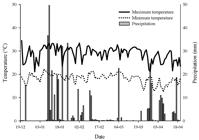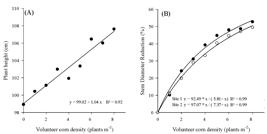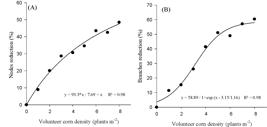ABSTRACT:
Volunteer corn is considered a weed when its emergence occurs during the crop cycle in succession, as is the case of volunteer corn plants of hybrids of Roundup Ready (RR) in crops implanted with RR soybean cultivars. The objective of this study was to verify the effect of the interference of different RR plant densities on the RR soybean crop, as well as to estimate the level of economic damage (NDE). For this, a field experiment was carried out at two sites in a factorial scheme with four replications, the treatments consisted of densities of volunteer corn RR (0; 1; 2; 3; 4; 5; 6; 7 and 8 plants m-2) competing in the entire soybean cycle. The changes in morphology and yield components behaved directly proportional to the increment of volunteer corn densities, with the variable vegetables per plant being the most strongly affected. The loss of soybean yield at the highest competitor density reached 58%. NDE was closely dependent on the cost of control of volunteer corn plants, crop yield expectancy, herbicide efficiency, and the price received for the harvested product, with yield expectancy the most impacting factor. In all simulations, NDE was found to be very low, less than 0.48 plants m-2 evidencing the need of herbicides in the control of RR volunteer corn even at low densities.
Keywords:
Glycine max; level of economic damage; volunteer corn density; yield loss

 Thumbnail
Thumbnail
 Thumbnail
Thumbnail
 Thumbnail
Thumbnail
 Thumbnail
Thumbnail
 Thumbnail
Thumbnail




